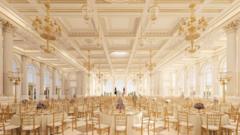Will the New $200 Million White House Ballroom Redefine Elegance?

The New White House Ballroom: A Vision Realized by President Trump
In a significant announcement, the White House has revealed plans to construct a new ballroom, a project that aligns with President Donald Trump's long-standing ambition. With an investment of $200 million, the ballroom promises to be a centerpiece of elegance and functionality, located adjacent to a modernized East Wing that houses key offices, including that of First Lady Melania Trump. The project, funded by Trump and anonymous donors, is set to commence in September and aims to enhance the hosting capabilities of the White House significantly.
The Vision Behind the Ballroom
For years, President Trump has expressed his desire for a ballroom that reflects the grandeur and historical significance of the White House. This new space, approximately 90,000 square feet with a seating capacity of about 650 people, stands to replace the current East Room, which accommodates only about 200 guests. This transition will not only alleviate logistical challenges but will also provide a more aesthetically pleasing venue for high-profile events, including state dinners.
A Solution to an Ongoing Challenge
Currently, formal events often necessitate the installation of a large tent in the White House grounds, a solution that many, including Trump, deem unsightly. The new ballroom aims to eliminate this need, offering a permanent venue that aligns with the White House’s architectural heritage, replete with ornate columns and luxurious chandeliers. According to White House Press Secretary Karoline Leavitt, this project is not merely an addition but a “much-needed and exquisite enhancement” to the White House.
Funding and Construction Timeline
Trump's commitment to fund the project, alongside contributions from anonymous donors, underscores the administration's focus on preserving the White House's legacy while enhancing its functionality. Construction is expected to be completed before the end of Trump's term in January 2029, ensuring that the ballroom can be utilized for future administrations and events.
Architectural Integrity and Modernization
The architectural renderings suggest that the ballroom will maintain the classic aesthetic of the White House, ensuring that it blends seamlessly with its surroundings. Chief of Staff Susie Wiles emphasized the importance of preserving the historical significance of the White House while also introducing modern conveniences. This dual focus is expected to resonate with both current and future generations of Americans.
Temporary Relocation of East Wing Offices
As construction progresses, offices currently housed in the East Wing, including that of Melania Trump, will be temporarily relocated. This move reflects the administration's commitment to minimizing disruption while ensuring the timely completion of the ballroom. The planned renovations represent a broader initiative to modernize the White House and enhance its role as a venue for national and international gatherings.
Trump's Historical Perspective
President Trump has often remarked on the historical context of the White House and the necessity for improvements. In his view, the new ballroom is not just an architectural project but a historical milestone that underscores his administration's commitment to revitalizing the nation's most iconic residence. Trump's assertion that "there's never been a President that's good at ballrooms" serves as both a critique of previous administrations and a declaration of his intentions to rectify this perceived oversight.
Building for the Future
Trump's ambition extends beyond mere aesthetics; it encompasses a vision of a functional space that can accommodate the evolving needs of the White House. The ballroom is expected to serve as a venue for high-profile events, diplomatic gatherings, and celebrations, reinforcing the White House’s status as a symbol of American unity and hospitality.
Conclusion: Embracing Change in Tradition
As the plans for the new ballroom move forward, they reflect a broader trend of modernization within a historic framework. The initiative not only addresses logistical challenges but also signifies a commitment to preserving the rich history of the White House while adapting to contemporary needs. This ambitious project stands as a testament to President Trump's vision for the future of the White House, blending tradition with modernity.
Frequently Asked Questions
What is the expected cost of the new White House ballroom?
The new ballroom is expected to cost approximately $200 million, funded by President Trump and anonymous donors.
What will be the seating capacity of the new ballroom?
The ballroom will have a seating capacity of about 650 guests, significantly larger than the current East Room.
When is construction expected to be completed?
Construction is anticipated to be completed long before the end of President Trump's term in January 2029.
How will the new ballroom impact White House events?
The new ballroom is expected to eliminate the need for temporary tents during large events, providing a permanent, elegant venue for formal gatherings.
What architectural style will the new ballroom reflect?
The new ballroom will be designed to blend with the existing architectural style of the White House, featuring lavish interiors and ornate columns.
The construction of the new ballroom at the White House not only aims to fulfill a long-held desire of President Trump but also represents a significant step in modernizing one of the nation’s most important historical buildings. With its blend of tradition and modernity, this project will undoubtedly leave a lasting legacy. Are you excited about the future of the White House and what this new ballroom represents for American culture and diplomacy? #WhiteHouse #TrumpBallroom #ModernHistory
Published: 2025-07-31 21:07:07 | Category: wales



